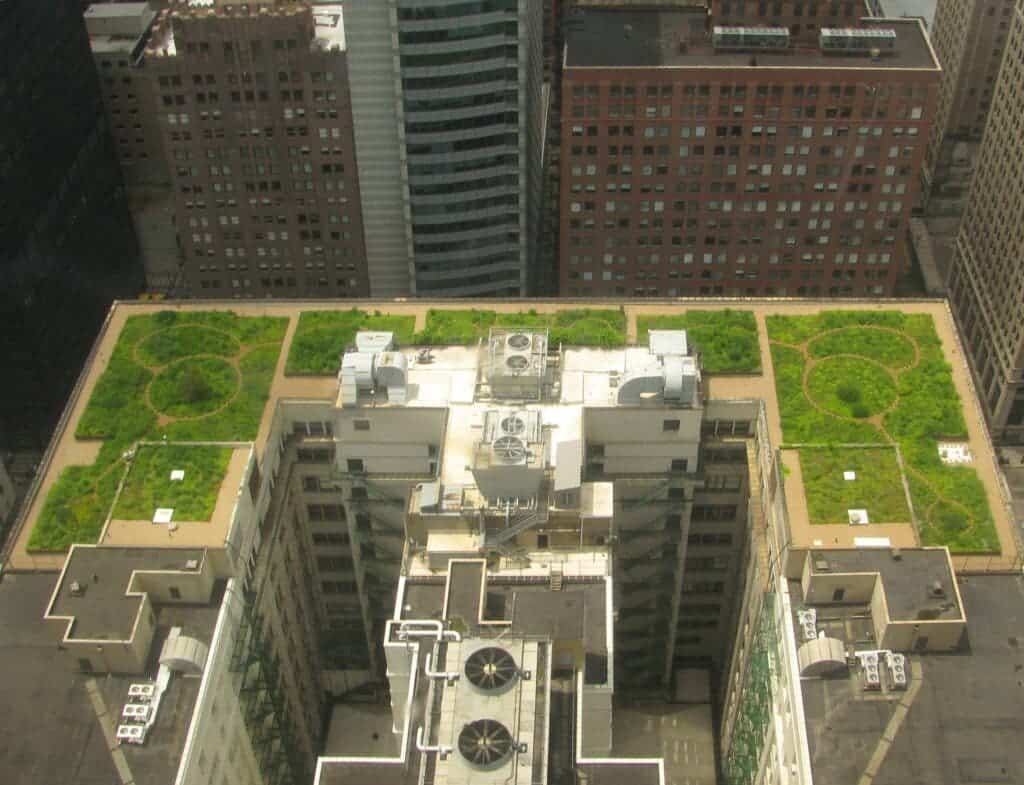Cities around the world are starting to embrace green roofs as a way to improve water quality, reduce peak flows, and decrease stormwater runoff. Although their installation might involve high upfront costs compared to a regular roof, their benefits are appreciated by urban residents, who seem willing to pay the extra cost, a new study has found.

Green roofs have a layer of plants on top of the roof, which usually comes with a layer of soil, material for waterproofing, structural support, and insulation. They absorb rainwater by the water buffering in the plants, substrate, and drainage layer, which delays the discharge of rainwater to the sewage system and reduces the risk of flooding. The plants in the green roof also filter particulate matter from the air and absorb and reflect sunlight, which helps to reduce the heat island effect in cities. The roofs provide significant, quantifiable benefits, but also raise costs in terms of installation and maintenance.
Portland is a world leader in the use of green stormwater infrastructure such as green roofs — in 2020, the city had about 2,500 green street facilities, and the number has increased since. In a new study, researchers from Reed College wanted to better understand how much Portland residents were willing to pay to increase green roofs in the city.
“Countries are investing significant public resources to reduce the impact of stormwater runoff,” Amy Ando, study author, said in a statement. “Green roofs are part of that solution because they capture some of the rain that would otherwise end up in sewage systems. Knowing the benefits from investing in green roofs is important for implementing public policies.”
Green roofs make a lot of sense

The study focused on how much people would pay for benefits such as increased presence of pollinators, reduced urban heat island effect, and reduced sewer overflow events (CSOs). Like in other cities, extreme rainfall events are a big problem in Portland and can lead to flooding – which impacts transportation, water quality, and properties.
Portland requires new buildings in the city center with a footprint of over 20,000 square feet to have a green roof covering 100% of the area to protect the city from flooding. The rule became official in 2018 as part of the city’s efforts to cope with the effects of climate change, including more frequent and intense extreme rainfall events.
“Although CSO events have declined dramatically in Portland after a major system upgrade ($1.4 billion “Big Pipe Project”), they still happen,” Noelwah Netusil, lead author on the paper, said in a statement. “Our findings show that survey respondents place the largest value on reducing CSO events further and are willing to support additional funding for this.”
The researchers surveyed residents in Portland, who indicated how much they would pay for a green roof to result in a scale of benefits. For example, for green roofs to reduce average temperature over 1 degree Fahrenheit, increase pollinators by 150%, and reduce sewer overflows by three every year, respondents were willing to pay $442 per household.
On a less ambitious level, for green roofs to reduce sewer overflow, increase pollinators by 50%, and reduce temperatures by less than 0.5 degrees, residents were willing to pay $202 per household. In either scenario, the cost would be added in monthly installments to their utility bills for one year and the green roofs would be set up a year later.
Survey respondents who had visited or seen a green roof had the highest willingness to pay for such a program. However, people who knew nothing about green roofs before the study also supported them. Also, people preferred green roofs to be spread out equally across the city instead of concentrated in the city center, as it’s the case now.
“Reducing CSO events had the largest value for all survey respondents—whether they had visited, seen, heard, or knew nothing about green roofs prior to taking the survey,” Netusil said in a statement. “The total estimated benefits from the programs we examined would be sufficient to more than double the number of green roofs.”
Of course, the results of the study should be read in a local context. But this study shows that at least in some locations, the interest and appreciation of green roofs have grown substantially, marking the advent of green roofs as both a useful and a popular approach.
The study was published in the journal Landscape and Urban Planning.


